Yoga improves flexibility and reduces stress, making it an effective practice for overall well-being. This article explores how yoga enhances physical mobility, employs stress reduction techniques, and adapts to chronic conditions. Research shows significant benefits, including a 30% improvement in flexibility and reduced anxiety levels. Tailored practices ensure safe participation for individuals with varying health needs.
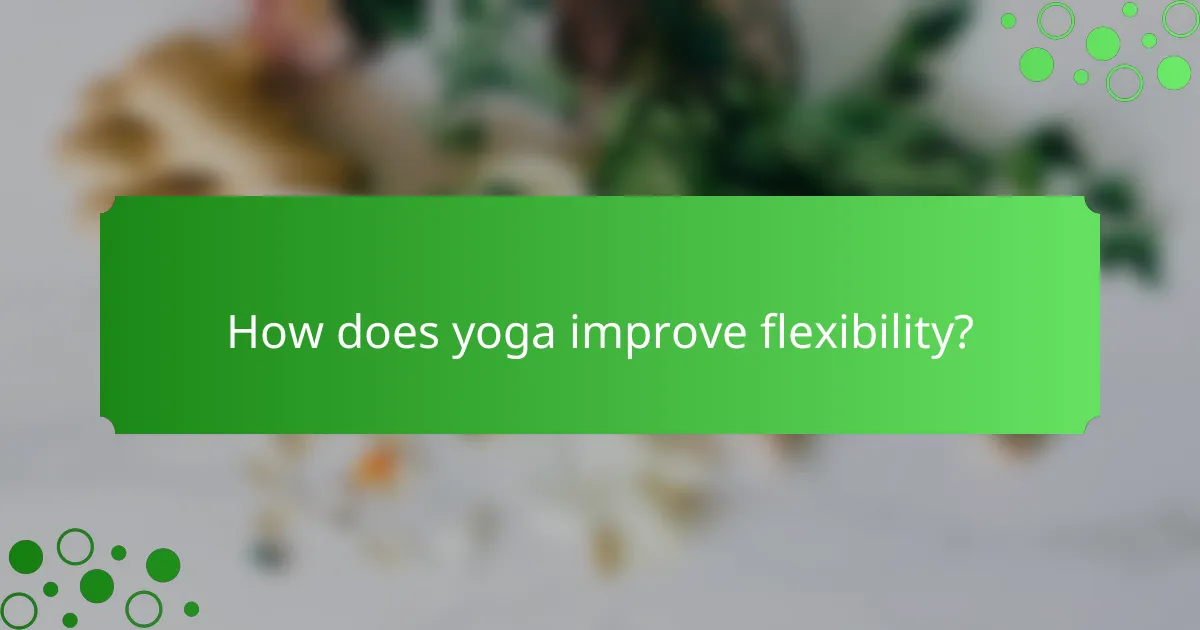
How does yoga improve flexibility?
Yoga significantly enhances flexibility through a combination of targeted stretching and mindful movement. This practice encourages muscle elongation and joint mobility, which can lead to improved range of motion. Regular participation in yoga can also alleviate stress, promoting relaxation and reducing muscle tension. Additionally, specific yoga adaptations can benefit individuals with chronic conditions by providing gentle, restorative movements that enhance flexibility while accommodating their needs.
What are the key postures for enhancing flexibility?
Key postures for enhancing flexibility in yoga include Downward Dog, Cobra Pose, and Seated Forward Bend. These postures effectively stretch major muscle groups, improve range of motion, and promote relaxation. Incorporating these poses into a regular practice can significantly enhance overall flexibility and reduce stress.
Which styles of yoga are most effective for flexibility training?
Hatha, Vinyasa, and Yin yoga are most effective for flexibility training. Hatha yoga focuses on basic postures and alignment, enhancing flexibility over time. Vinyasa yoga incorporates fluid transitions between poses, promoting dynamic stretching and flexibility. Yin yoga targets deep connective tissues, improving flexibility through long-held postures. These styles effectively address flexibility improvements, stress reduction techniques, and adaptations for chronic conditions.
How does consistency in practice influence flexibility gains?
Consistency in practice significantly enhances flexibility gains in yoga. Regular engagement with yoga postures promotes muscle elasticity and joint mobility, leading to improved overall flexibility. Additionally, consistent practice aids in stress reduction, which can further facilitate physical relaxation and adaptability. Individuals with chronic conditions may also experience tailored flexibility improvements, as ongoing practice allows for gradual adaptations to their specific needs. Thus, consistency not only builds physical capacity but also fosters a supportive environment for mental and emotional well-being.
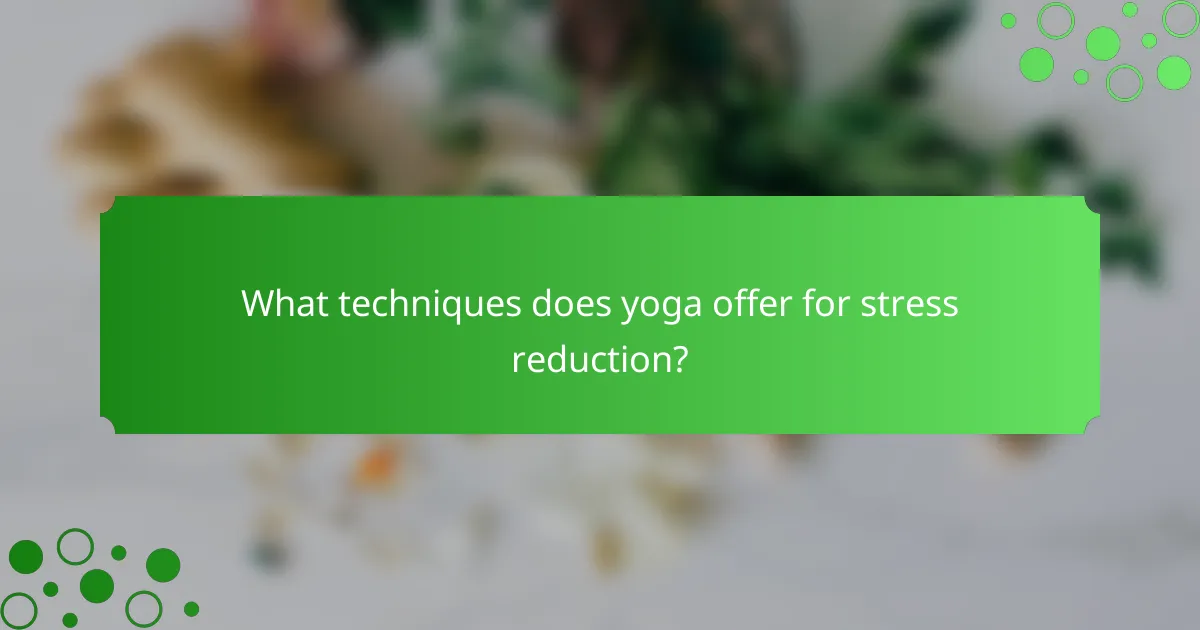
What techniques does yoga offer for stress reduction?
Yoga offers various techniques for stress reduction, including mindful breathing, meditation, and physical postures. These practices enhance relaxation and promote mental clarity. Mindful breathing helps regulate the nervous system, while meditation fosters a sense of calm. Additionally, specific postures, like child’s pose and forward bends, physically release tension. Regular practice can lead to long-term stress management benefits, making yoga a valuable tool for overall well-being.
How can breath control enhance stress relief in yoga?
Breath control enhances stress relief in yoga by promoting relaxation and mindfulness. Controlled breathing techniques, such as pranayama, can lower cortisol levels and improve focus. This practice encourages a state of calm, making it easier to manage stress. Additionally, deep breathing activates the parasympathetic nervous system, which further reduces anxiety and tension. Regular practice can lead to long-term benefits, including improved emotional resilience and a greater sense of well-being.
What role does mindfulness play in stress management through yoga?
Mindfulness plays a crucial role in stress management through yoga by enhancing focus and promoting relaxation. It encourages practitioners to be present and aware, reducing anxiety levels. Techniques such as breath control and meditation foster a calming environment, leading to lower cortisol levels. Additionally, yoga’s adaptability allows individuals with chronic conditions to engage mindfully, further alleviating stress. This holistic approach integrates physical postures with mental clarity, creating a comprehensive strategy for stress reduction.
Which yoga practices are best for immediate stress relief?
Yoga practices that provide immediate stress relief include restorative yoga, gentle flow, and mindfulness meditation. Restorative yoga uses props to support the body, promoting relaxation and reducing tension. Gentle flow combines movement with breath, enhancing flexibility and calming the mind. Mindfulness meditation focuses on present awareness, helping to alleviate anxiety. Integrating these practices can lead to significant improvements in stress management and overall well-being.
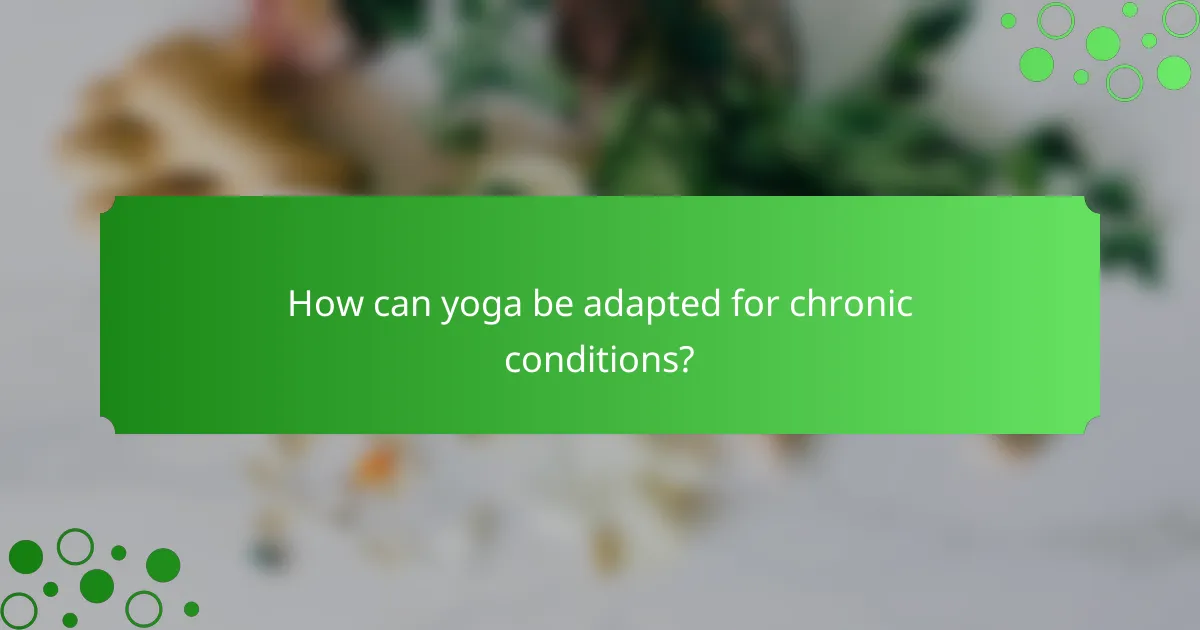
How can yoga be adapted for chronic conditions?
Yoga can be effectively adapted for chronic conditions through tailored poses and techniques. Modifications focus on improving flexibility, reducing stress, and accommodating individual limitations. For instance, restorative yoga poses can alleviate pain and enhance mobility. Incorporating breathwork techniques can significantly lower anxiety levels. Additionally, gentle stretching routines promote physical well-being while respecting personal boundaries. The adaptability of yoga makes it a valuable tool for managing chronic conditions, fostering both physical and mental health.
What specific modifications are recommended for common chronic illnesses?
Yoga can significantly aid in managing common chronic illnesses through flexibility improvements, stress reduction techniques, and tailored adaptations. Recommended modifications include gentle poses for joint mobility, breath control for anxiety relief, and modified postures for individual abilities.
For arthritis, focus on low-impact poses to enhance flexibility and reduce pain. For diabetes, incorporate practices that lower stress and promote better blood sugar control. Individuals with heart conditions should prioritize restorative yoga to improve cardiovascular health.
Incorporating these specific adaptations can lead to improved overall well-being for those with chronic conditions.
How does yoga address pain management in chronic conditions?
Yoga effectively manages pain in chronic conditions through flexibility improvements, stress reduction techniques, and tailored adaptations. Increased flexibility enhances mobility and reduces stiffness, which directly alleviates pain. Stress reduction techniques, such as mindfulness and breathing exercises, lower cortisol levels, decreasing pain perception. Additionally, adaptations in yoga practices cater to individual needs, ensuring safety and comfort for those with chronic conditions. This holistic approach empowers individuals to manage their pain actively and improve overall well-being.
What are the benefits of restorative yoga for chronic illness sufferers?
Restorative yoga offers significant benefits for chronic illness sufferers, including enhanced flexibility, stress reduction, and tailored adaptations for various conditions.
Flexibility improvements from restorative yoga can alleviate muscle tension and improve range of motion, which is crucial for individuals with chronic pain. Stress reduction techniques, such as deep breathing and gentle postures, promote relaxation and decrease anxiety, positively impacting overall health. Additionally, restorative yoga can be adapted to accommodate specific chronic conditions, ensuring that practitioners receive the support they need without overexertion.
Research indicates that regular practice can lead to improved quality of life and better management of symptoms associated with chronic illnesses.

Why is a holistic approach important in yoga for health?
A holistic approach in yoga is vital for enhancing overall health by integrating flexibility improvements, stress reduction techniques, and adaptations for chronic conditions. This comprehensive method fosters a balanced mind-body connection, promoting physical well-being and emotional resilience.
Flexibility improvements through yoga enhance physical mobility and reduce injury risk. Stress reduction techniques, such as mindfulness and breath control, lower cortisol levels and improve mental clarity. Adaptations for chronic conditions ensure that individuals can practice safely and effectively, catering to their specific health needs.
Research indicates that regular yoga practice can lead to a 30% improvement in flexibility and a significant reduction in stress levels. This multifaceted approach empowers individuals to manage their health proactively and sustainably.
How does yoga integrate physical, mental, and emotional well-being?
Yoga integrates physical, mental, and emotional well-being through flexibility improvements, stress reduction techniques, and adaptations for chronic conditions. Practicing yoga enhances flexibility by promoting muscle elasticity and joint mobility, which can alleviate physical discomfort. Stress reduction is achieved through mindfulness and breathing techniques, fostering mental clarity and emotional stability. Additionally, yoga can be adapted to accommodate chronic conditions, making it accessible for individuals with varying levels of ability and health challenges. This holistic approach supports overall wellness, addressing both the body and mind.
What are the long-term health benefits of practicing yoga regularly?
Practicing yoga regularly offers significant long-term health benefits, including improved flexibility, reduced stress levels, and adaptations for managing chronic conditions.
Yoga enhances flexibility by promoting muscle elasticity and joint mobility, which can prevent injuries and improve physical performance. Stress reduction techniques in yoga, such as deep breathing and mindfulness, lower cortisol levels and promote mental well-being. Additionally, yoga can be adapted for chronic conditions, providing tailored movements that support recovery and enhance quality of life.
Studies show that individuals who practice yoga regularly report lower rates of anxiety and depression, demonstrating its effectiveness as a holistic health approach.
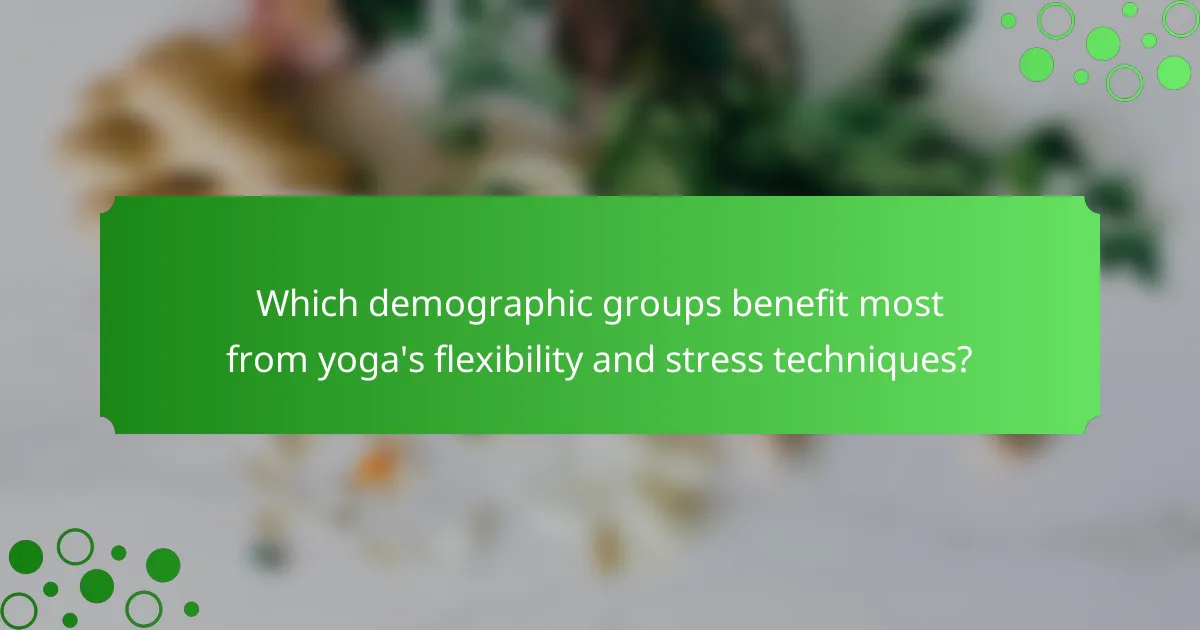
Which demographic groups benefit most from yoga’s flexibility and stress techniques?
Certain demographic groups benefit significantly from yoga’s flexibility improvements and stress reduction techniques. These groups include older adults, individuals with chronic pain, athletes, and those experiencing high-stress levels.
Older adults often find enhanced mobility and balance through yoga, which can reduce fall risk. Individuals with chronic pain, such as arthritis sufferers, benefit from tailored yoga practices that promote gentle stretching and relaxation. Athletes use yoga to improve flexibility and aid recovery, reducing the risk of injury. Lastly, those experiencing high-stress levels utilize yoga’s mindfulness and breathing techniques to manage anxiety and promote mental well-being.
Research shows that 30% of older adults report improved mobility, while 70% of athletes feel yoga enhances their performance. These statistics highlight yoga’s adaptability across various demographics, making it a valuable practice for enhancing physical and mental health.
How do age and physical ability influence yoga practice efficacy?
Age and physical ability significantly influence the efficacy of yoga practice. Older individuals may experience slower flexibility improvements, while those with physical limitations might require tailored adaptations.
Research indicates that yoga can enhance flexibility by up to 30% in older adults, promoting joint health and mobility. Stress reduction techniques like mindful breathing are beneficial for all ages, helping to lower cortisol levels. Chronic conditions such as arthritis or osteoporosis necessitate specific modifications to ensure safety and effectiveness in practice.
Adaptations may include using props or chair yoga for those with limited mobility, ensuring all practitioners can experience the benefits of yoga. Regular practice fosters resilience, regardless of age or ability, making yoga a versatile tool for well-being.
What trends are emerging in yoga practice among diverse populations?
Emerging trends in yoga practice among diverse populations include increased focus on flexibility improvements, stress reduction techniques, and adaptations for chronic conditions. Many practitioners incorporate modifications to accommodate individual needs, enhancing accessibility.
A notable trend is the integration of mindfulness practices within yoga sessions, promoting mental well-being alongside physical benefits. This approach resonates with diverse groups seeking holistic health solutions.
Additionally, community-centered classes are gaining popularity, fostering inclusivity and support among participants. These sessions often emphasize shared experiences and cultural relevance, creating a welcoming environment for all.
Finally, technology’s role in yoga is expanding, with online platforms offering diverse instructional styles and accessibility options. This trend allows practitioners from varied backgrounds to engage with yoga, regardless of location or physical ability.
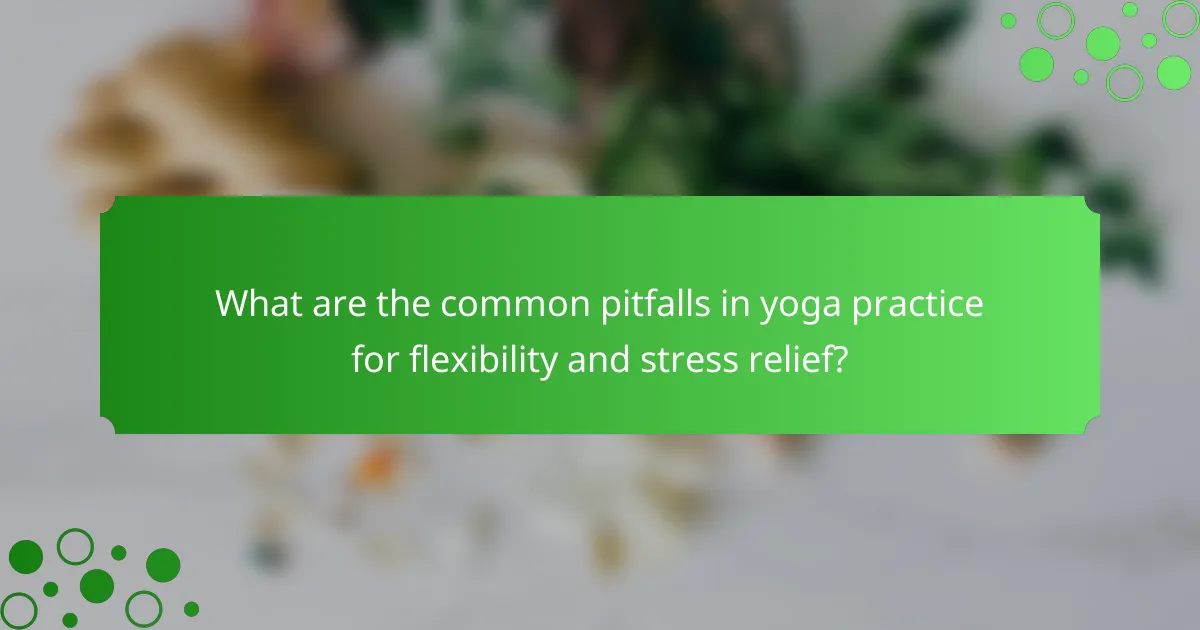
What are the common pitfalls in yoga practice for flexibility and stress relief?
Common pitfalls in yoga practice for flexibility and stress relief include overexertion, neglecting proper alignment, and inconsistent practice. Overexertion can lead to injuries, hindering progress. Proper alignment is crucial; poor form can cause strain rather than relief. Inconsistent practice fails to build the necessary flexibility and stress management skills. Additionally, focusing solely on physical postures without integrating breathwork can limit stress reduction benefits. Prioritizing a balanced approach enhances both flexibility and stress relief outcomes.
How can practitioners avoid injury while improving flexibility?
Practitioners can avoid injury while improving flexibility by focusing on proper alignment, gradual progression, and listening to their bodies. Incorporating restorative yoga poses enhances flexibility without strain. Consistent practice promotes muscle adaptation, reducing injury risks. Using props supports safe stretching and encourages deeper relaxation, aiding stress reduction.
What misconceptions about yoga might hinder its effectiveness?
Misconceptions about yoga can significantly hinder its effectiveness. Many believe yoga solely improves flexibility, overlooking its stress reduction techniques and adaptations for chronic conditions.
Some common misconceptions include the idea that yoga is only for the physically fit, which can deter those with chronic conditions from participating. Additionally, the belief that yoga is a passive practice may lead individuals to miss out on its active stress management benefits.
Another misconception is that all yoga styles are the same, which ignores the unique attributes of different forms that cater to specific needs. For example, restorative yoga focuses on relaxation and can be particularly beneficial for stress relief.
Finally, assuming that yoga requires a significant time commitment can prevent individuals from incorporating short sessions into their daily routine, limiting their exposure to its benefits.
What expert tips can enhance the benefits of yoga for flexibility and stress?
Incorporating expert tips can significantly enhance yoga’s benefits for flexibility and stress reduction. Focus on consistent practice, integrating breath control, and utilizing props for support.
1. Practice regularly, aiming for at least three times a week to improve flexibility and reduce stress effectively.
2. Incorporate breath-focused techniques, such as pranayama, to deepen relaxation and enhance the mind-body connection.
3. Use props like blocks and straps to achieve correct alignment and support deeper stretches safely.
4. Explore restorative yoga poses to promote relaxation and alleviate tension, especially beneficial for chronic conditions.
5. Set a calming environment with soft lighting and soothing music to enhance the overall experience and encourage mindfulness.